Last updated on April 19th, 2024 at 08:47 am
Growing plants indoors comes with challenges, but anyone can cultivate a thriving indoor garden with the right knowledge and tools. One essential tool for indoor plant enthusiasts is the use of grow lights. In this comprehensive guide, we will delve into the specifics of using grow lights for indoor plants, ensuring your green companions receive the light they need for robust growth.
Indoor gardening is trendy, creating a little green paradise at home. But, indoors, they often miss the sunlight plants love. That’s where grow lights become heroes, giving plants the light they need for photosynthesis and good health.
Contents
- 1 The Importance of Grow Lights for Indoor Plants
- 2 Different Types Of Grow Lights
- 3 Installation Tips for Optimal Grow Light Performance
- 4 FAQs
- 4.1 Why do indoor plants need to grow lights?
- 4.2 How do grow lights supplement natural sunlight?
- 4.3 Why is the light spectrum crucial for indoor gardening?
- 4.4 How do grow lights enhance photosynthesis?
- 4.5 Can grow lights extend growing seasons for indoor plants?
- 4.6 What types of grow lights are suitable for indoor plants?
- 4.7 How do I choose the right spectrum of grow lights for my indoor plants?
- 4.8 What are the advantages of using fluorescent grow lights for indoor plants?
- 4.9 How can I ensure the optimal performance of grow lights for indoor plants?
- 5 Author
The Importance of Grow Lights for Indoor Plants
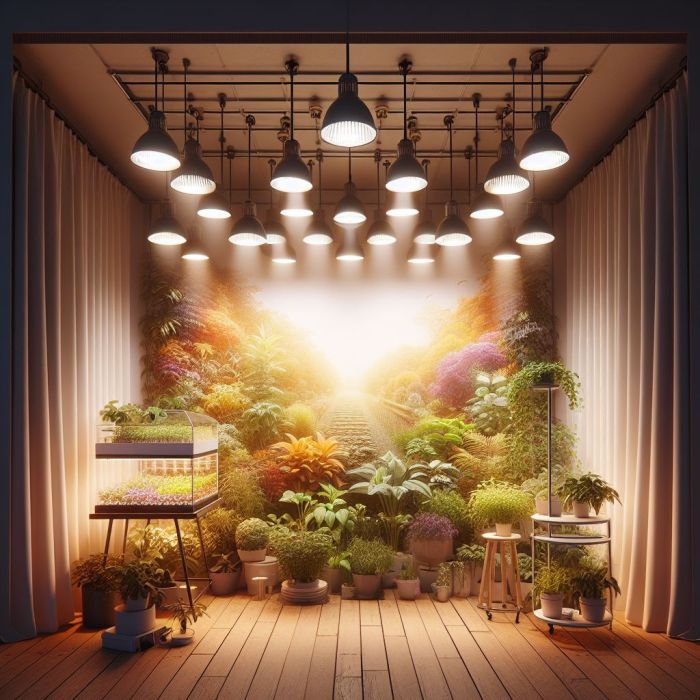
Indoor gardening has become increasingly popular, providing a touch of nature within homes. However, not all indoor spaces receive ample natural sunlight, which is essential for plants to thrive. This is where the importance of grow lights comes into play.
Supplementing Natural Sunlight:
Many indoor plants, especially in areas with limited sunlight exposure, require additional light sources to meet their energy needs. Grow lights for indoor plants serve as an effective supplement to natural sunlight, ensuring that plants receive the essential light spectrum for photosynthesis.
Crucial Light Spectrum:
Choosing the right spectrum of grow lights for your indoor plants is crucial for successful indoor gardening. Different growth stages demand specific light wavelengths, and understanding this is key to fostering healthy and robust plants. Opt for grow lights that offer a balanced spectrum, including red and blue wavelengths, to support the entire life cycle of your indoor plants.
Whether it’s the vegetative phase or flowering stage, the right spectrum ensures optimal photosynthesis and overall plant well-being. Dive into the world of “grow lights for indoor plants” and illuminate your space with the perfect spectrum for flourishing greenery.
Enhanced Photosynthesis:
Photosynthesis, the process by which plants convert light into energy, is fundamental to their growth. Grow lights facilitate and enhance this process, fostering robust photosynthesis even in environments with minimal natural light. This is particularly beneficial for plants that struggle to thrive in low-light conditions.
Extended Growing Seasons:
Specifically designed grow lights for indoor plants, enable indoor gardeners to extend the growing seasons for their plants. This is advantageous for those cultivating a variety of plants, including fruits and vegetables, as it allows for a continuous harvest throughout the year, irrespective of external weather conditions.
Precise Control:
Modern grow lights offer precise control over light intensity, duration, and spectrum. This level of control allows growers to tailor the lighting conditions to the specific requirements of different plant species, creating an optimal environment for their growth.
Optimal Plant Health:
Adequate and well-managed light conditions, including the use of grow lights for indoor plants, contribute significantly to overall plant health. With grow lights, indoor gardeners can address the challenges posed by inadequate sunlight, preventing issues such as leggy growth, pale leaves, and reduced flowering or fruiting.
Different Types Of Grow Lights
Fluorescent Lights
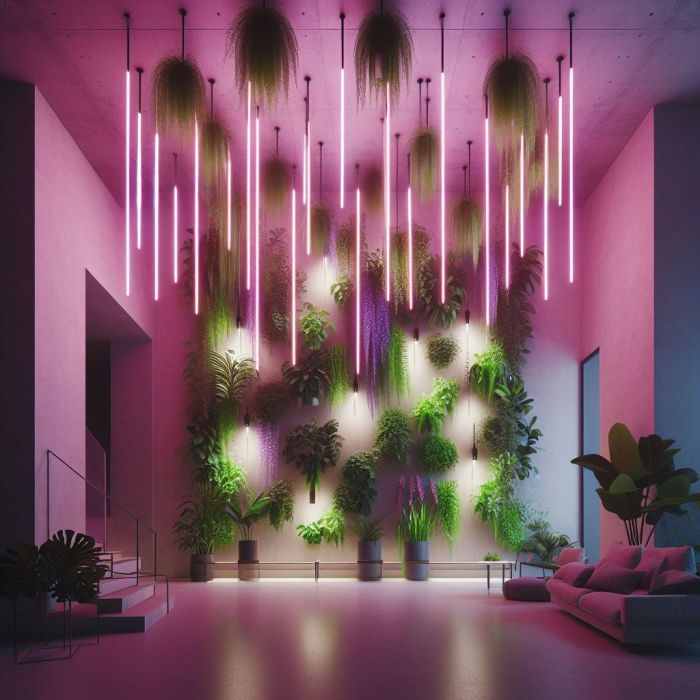
Fluorescent lights shine in the realm of indoor gardening, notable for their energy efficiency. These lights, favored for nurturing seedlings and young plants, emit a spectrum finely tuned for early plant growth. Fluorescent lights, including grow lights for indoor plants, play a significant role in the initial stages of a plant’s development.
Apart from their effectiveness, they are cost-effective and energy-efficient, making them a preferred choice for indoor gardeners. Their ability to produce less heat ensures a conducive environment for delicate phases of plant growth, solidifying their appeal in the world of indoor horticulture.
LED Lights
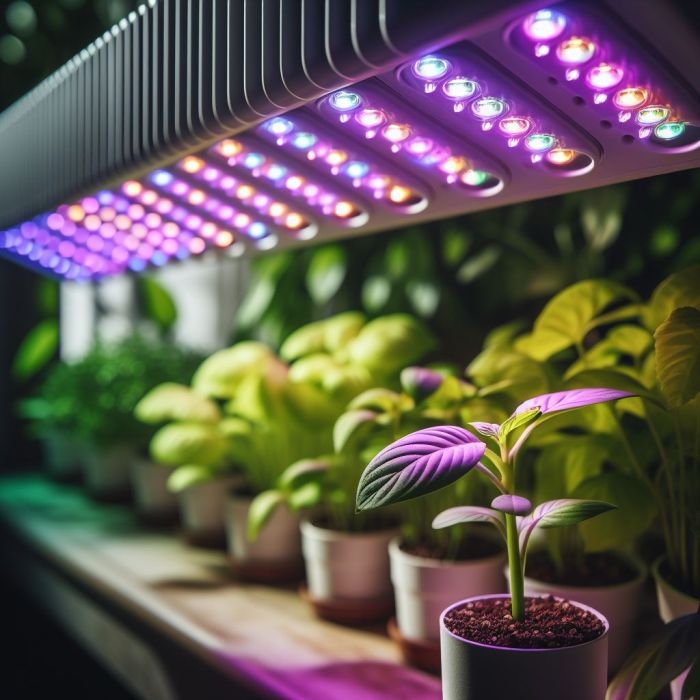
LED lights have become a go-to choice for indoor plant enthusiasts. These lights are versatile and allow customization for different growth stages with a balanced spectrum, making them energy-efficient and long-lasting. The ability to tailor the light spectrum is a great benefit for the overall health of indoor plants. As an essential component for indoor gardening, LED lights contribute significantly to the well-being of your green companions.
HID Lights
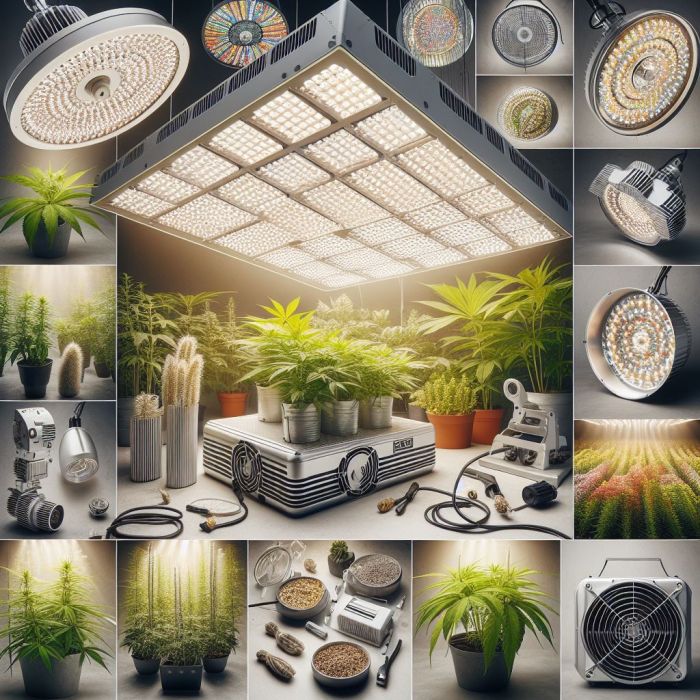
High-Intensity Discharge (HID) lights, such as Metal Halide (MH) and High-Pressure Sodium (HPS), are powerful options for mature indoor plants. MH lights with their blue-rich spectrum are perfect for the vegetative phase, while HPS lights, rich in red wavelengths, support flowering and fruiting. With high light intensity, these grow lights for indoor plants effectively cater to the entire growth cycle, ensuring optimal conditions for your indoor garden.
- MH Lights
Metal Halide (MH) lights emit a cool, blue-white light that encourages compact vegetative growth, making them ideal for the early stages of plant development, promoting strong stems and lush foliage.
- HPS Lights
High-pressure sodium (HPS) lights emit a warm, red-orange light that is beneficial during the flowering and fruiting stages of plant growth. These lights enhance yields by providing the specific spectrum needed during these crucial phases. Incorporating both MH and HPS grow lights for indoor plants ensures comprehensive support for the entire growth cycle.
Installation Tips for Optimal Grow Light Performance
Proper installation of grow lights for indoor plants is crucial for ensuring optimal performance and promoting the health of your indoor plants. Follow these key tips for setting up your grow lights:
Choose the Right Hanging Height:
Adjust the height of your grow lights based on the specific needs of your plants. Different stages of growth may require varying light intensities, so maintain flexibility in hanging heights.
Provide Adequate Spacing:
Ensure that each plant receives uniform light coverage by spacing them appropriately. Avoid overcrowding, as it can lead to uneven light distribution and hinder the growth of certain plants.
Understand Light Intensity:
Different plants have varying light intensity requirements. Research the light needs of your specific plants and adjust the distance between the plants and the lights accordingly.
Consider Light Duration:
Mimic natural sunlight cycles by regulating the duration of light exposure. Most plants benefit from 12 to 16 hours of light daily, but this can vary, so research the light duration preferences of your plants.
Use Timers for Consistency:
Employ timers to maintain a consistent light schedule. This ensures that your plants receive the right light each day, promoting steady growth.
Monitor Temperature:
Grow lights emit heat, and excessive heat can harm plants. Install fans or use a ventilation system to regulate the temperature, creating an optimal environment for plant growth.
Adjust as Plants Grow:
As your plants grow, adjust the hanging height of the lights to accommodate their increasing size. This ensures that all plant parts receive adequate light for proper development.
By following these installation tips, you can establish an effective grow light setup that maximizes plant growth and fosters a thriving indoor garden.
FAQs
Why do indoor plants need to grow lights?
Indoor plants, especially those in spaces with limited sunlight, require supplemental light for photosynthesis and overall health. Grow lights provide the necessary light spectrum, ensuring optimal growth.
How do grow lights supplement natural sunlight?
Grow lights serve as an effective supplement to natural sunlight by providing a balanced spectrum, including red and blue wavelengths. This supports photosynthesis and caters to different growth stages.
Why is the light spectrum crucial for indoor gardening?
The right spectrum, including red and blue wavelengths, is crucial for successful indoor gardening. It supports the entire life cycle of indoor plants, from the vegetative phase to flowering, ensuring optimal photosynthesis.
How do grow lights enhance photosynthesis?
Grow lights facilitate and enhance photosynthesis, allowing plants to convert light into energy even in environments with minimal natural light. This is particularly beneficial for plants in low-light conditions.
Can grow lights extend growing seasons for indoor plants?
Yes, specifically designed grow lights for indoor plants enable gardeners to extend growing seasons. This is advantageous for cultivating various plants, ensuring a continuous harvest throughout the year.
What types of grow lights are suitable for indoor plants?
Various grow lights, such as fluorescent lights, LED lights, and HID lights (MH and HPS), are suitable for indoor plants. Each type has its advantages, catering to different plant needs and growth stages.
How do I choose the right spectrum of grow lights for my indoor plants?
To choose the right spectrum, consider the specific light requirements of your plants at different growth stages. Opt for grow lights that offer a balanced spectrum, including red and blue wavelengths.
What are the advantages of using fluorescent grow lights for indoor plants?
Fluorescent lights are energy-efficient, cost-effective, and suitable for nurturing seedlings and young plants. They emit a spectrum finely tuned for early plant growth and produce less heat, making them conducive for delicate growth phases.
How can I ensure the optimal performance of grow lights for indoor plants?
Proper installation is crucial. Adjust hanging heights based on plant needs, provide adequate spacing, understand light intensity requirements, regulate light duration with timers, monitor temperature, and adjust as plants grow for optimal performance.
In conclusion, the world of indoor gardening thrives with the assistance of grow lights for indoor plants. From supplementing sunlight to providing a crucial light spectrum, these lights play a pivotal role in ensuring optimal plant health. Understanding your plants ‘ unique needs is key, whether it’s extending growing seasons, exercising precise control, or choosing between fluorescent, LED, or HID lights.
Embrace the realm of “grow lights for indoor plants,” implement proper installation tips, and witness the magic unfold as your indoor garden flourishes with vibrant life, thanks to the transformative power of grow lights. Illuminate your space and nurture your green companions to create a harmonious blend of technology and nature within the comfort of your home.

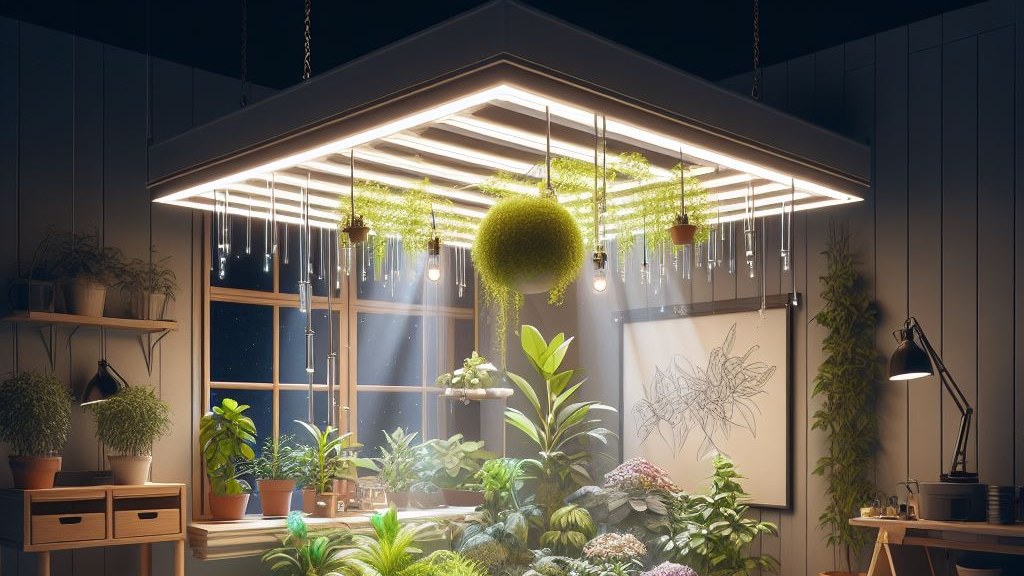
4 thoughts on “Grow Lights for Indoor Plants: Illuminate Your Indoor Oasis for Vibrant Growth”